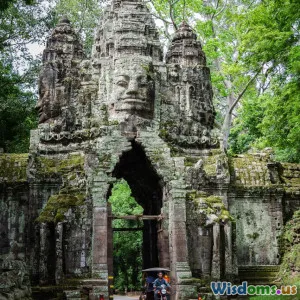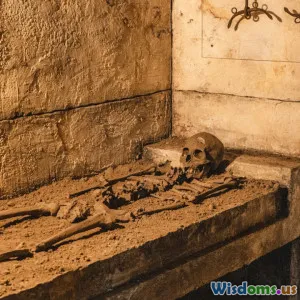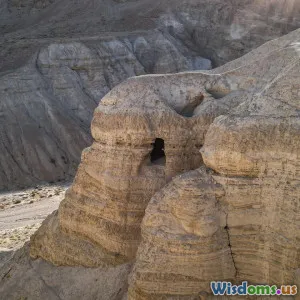
Unlocking the Secrets of Gobekli Tepe’s Builders
13 min read Discover the ingenious minds behind Göbekli Tepe through archaeological insights, surprising findings, and lasting mysteries of this ancient marvel predating Stonehenge. (0 Reviews)
Unlocking the Secrets of Göbekli Tepe’s Builders
Introduction
Who built Göbekli Tepe? Nestled on a remote Turkish hillside, this vast complex predates Stonehenge by some 6,000 years—yet its creators remain shadowy figures lost to time. The site’s massive stone pillars, carved with animals and mysterious symbols, have been rewriting the story of civilization, challenging everything we once believed about our ancient ancestors. How did Stone Age people, before the invention of metal tools or the wheel, raise multi-ton pillars and organize temple construction on a scale unseen for thousands of years? Were these hunter-gatherer societies capable of engineering wonders and structured collaboration that rivaled later monumental builders? The answers, as archaeologists dig deeper, are as fascinating as they are transformative.
The Astonishing Discovery: Rewriting History’s Timeline
A Hidden Hill’s Secret
Göbekli Tepe literally means “Potbelly Hill” in Turkish, an unassuming name for what would become the most important archaeological discovery of the 21st century. Beneath its gentle slopes, German archaeologist Klaus Schmidt was stunned in 1994 to uncover circle after circle of T-shaped limestone pillars, some towering 16 feet high and weighing up to 20 tons. This was not a simple domestic site, but a megalithic sanctuary—constructed nearly 11,600 years ago.
"This is the first human-built holy place," Schmidt once declared.
The sheer antiquity of Göbekli Tepe has forced historians to reconsider theories on the birth of civilization. Long-held dogma taught that only once agriculture emerged could humans settle, organize religion, and build complex societies. Göbekli Tepe vanished this narrative: its earliest layers predate agriculture altogether. Its builders were still hunter-gatherers, yet they left behind one of the ancient world’s greatest architectural enigmas.
Engineering Marvels: Monumental Construction Without Metal
The Logistics of Building with Stone Tools
How could nomadic bands, without the wheel or beasts of burden, accomplish what even today would require skilled planning and cooperation? Each of Göbekli Tepe’s dozens of rectangular enclosures encircled paired T-shaped monoliths, sculpted from local limestone. Using only flint tools, they cut, transported, and raised megaliths weighing up to 16 tons. Modern experiments by the German Archaeological Institute have demonstrated that with ropes, wooden sledges, and a well-organized workforce, these feats are at least plausible—if staggering in their ambition for the era.
Social Scale and Labor Organization
Estimates suggest organizing and constructing each enclosure demanded hundreds of workers. Site supervisor Lee Clare notes: “This wasn’t a small, ad-hoc task. It would require logistic planning, provisioning, and cooperation far beyond what we previously attributed to hunter-gatherers.”
What supplied the required calories to laborers in a pre-agricultural society? Remains of wild game, especially gazelles and aurochs, hint at gigantic community feasting events. Recent chemical analysis of animal bones shows signs of butchering and roasting, possibly for celebration or ritual, feeding hundreds at a time—incentives that may have drawn groups together seasonally to accomplish these immense projects.
Symbolism and Religious Purpose: Göbekli Tepe as a Pilgrimage Center
The Meaning Behind the Megaliths
Rising out of stone circles, abstract T-shapes stand with their surfaces adorned in exquisitely carved foxes, boars, scorpions, and cryptic vultures. Some pillars bear outstretched arms in low relief, suggesting, perhaps, that the mighty stones were conceived as stylized deities or ancestral spirits, guardians over sacred rituals.
Then there is the layout: enclosures are aligned to astronomical features or landscape markers, yet no evidence of permanent habitation has been discovered on-site—no homes, cooking hearths, or storage. This, many archaeologists believe, suggests Göbekli Tepe was a gathering spot, perhaps for seasonal rituals, feasting, and social cohesion.
Global Parallels—But With a Twist
Across the world, societies have erected megalithic monuments—from the passage tombs of Newgrange to Stonehenge—but Göbekli Tepe‘s age blows away the usual chronology. Unlike later sites, its builders were not yet villagers or farmers, but wandering bands who traversed great distances for collaborative rites.
Mystery of the Builders: Who Were These Ancient People?
Life at the Edge of the Neolithic Revolution
Archaeobotanical studies show wild cereals likely flourished in the region around 9500 BCE, providing both foraging and gathering opportunities. The type and stratification of flint tools, alongside obsidian artifacts from as far as Cappadocia (over 300 kilometers away), indicate broad trade networks—evidence that knowledge, art, and commerce connected Göbekli Tepe’s builders to wider Paleolithic communities.
Genetic research published in Nature (2021) compared ancient DNA from regional remains, suggesting a surprisingly mobile, genetically diverse population. Isotopic signatures indicate some members lived their entire lives wandering across the Fertile Crescent before contributing to this monumental project.
Organization–The Dawn of Leadership and Specialization?
The logistics implied structured leadership. There must have been visionaries: planners, spiritual leaders, artisans, stonecutters, labor coordinators. The scale hints at the earliest forms of social hierarchy, prefiguring priesthoods and the division of labor central to all later civilizations.
“The builders of Göbekli Tepe were shaping both the landscape and the minds of people who would come after.” — Dr. Jens Notroff, German Archaeological Institute
Why Bury Their Own Legacy?
One lasting conundrum: successive generations at Göbekli Tepe deliberately buried their most sacred enclosures in massive backfill, layer by layer, before building new ones on top. This intentional burial preserved the oldest sanctuaries in pristine condition—but why obliterate their own handiwork? Theories abound, from shifting ritual practices to a symbolic act of rebirth. Whatever the purpose, the deliberate covering is unmatched among known megalithic sites and remains unsolved.
Artistic Innovation: Iconography and Carvings
Animal Motifs—Ancestral Guardians or Cosmic Symbolism?
A menagerie of wild creatures dances—etched, in some cases, nearly life-sized—across Göbekli Tepe’s standing stones. No writing system clarifies their intent, but the prevalence of carnivores like snakes, scorpions, and foxes hints at beliefs in protective or dangerous spirit worlds.
“We must imagine a culture where animals carried powerful meaning, possibly acting as clan emblems or cosmic mediators,” posits iconography specialist, Dr. David Lewis-Williams.
Recent microscopic analysis revealed pigment residues, indicating that carvings were originally painted—further vivifying sacred stones to dazzle ritual participants.
Stranger Still: Abstract and Human Imagery
Alongside animal motifs, anthropomorphic arms, belts, and hands subtly emerge, culminating in the haunting “vulture stone,” whose carvings may hint at complex spiritual rites believed to hurry souls toward the afterlife—a theme echoed in nearby contemporary cave art.
Göbekli Tepe and the Origins of Civilization
Old Certainties Toppled
For centuries, Western scholars assumed societal complexity trailed agriculture: first you farm, then you settle, then you organize religion and public life. Yet Göbekli Tepe’s temples arose at the dawn of plant domestication, suggesting a radical alternate scenario—ritual centers may have inspired, not resulted from, settled farming communities.
Archaeologist Ian Hodder hypothesizes, “Ritual and symbolic activity drove human groups together, eventually requiring fixed resources—and these pressures gave birth to agriculture.” Chipped stone blades uncovered nearby—that show experimental cereal processing—offer tantalizing proof that the monument and emerging cultivation were inextricably linked.
Community, Identity, and Cultural Transmission
Archaeologists believe the construction of Göbekli Tepe forged a shared identity among disparate human groups. This period marked, for the first time, large-scale project management, religious expression, and the harnessing—and celebrating—of cooperative power. In many senses, this marks the cradle of organized civilization itself.
Ongoing Mysteries and the Future of Excavation
Only a Fraction Unveiled
Despite global interest, less than 10% of the site has been excavated. Geomagnetic surveys and satellite imagery expose entire swathes of buried stone circles yet to be revealed. As subsequent digs commence (paused periodically for conservation and security), archaeologists anticipate new finds to challenge even the most seasoned experts’ interpretations.
Discoveries in recently opened enclosures have already yielded new carving motifs, intricate ground plans, and puzzling artifacts—including ruined stone “benches” suggesting gatherings of worshippers or clan leaders. Specialists liken the state of ongoing research to an unfolding, multi-chapter detective story.
Technology Meets the Past
Cutting-edge imaging and analysis have enabled non-destructive site exploration and artifact reconstruction. Three-dimensional modeling and photogrammetry are helping researchers digitally archive fragile surfaces and reintegrate scattered carvings, while isotopic and residue analysis steadily close the gaps in our knowledge about ancient diets, trade, and migration.
Conclusion: Göbekli Tepe’s Builders—Pioneers of Human Imagination
The people who built Göbekli Tepe remain anonymous—but their legacy endures powerfully. Rising atop a Turkish hill, their sanctuaries defy the simple labels of “primitive.” These were not just builders, but visionaries: the first to raise great monuments by imagination, shared purpose, and inspired faith, setting humanity on its journey toward civilization and collective memory.
While their exact motivations—whether practical, spiritual, or social—remain mysterious, it’s clear the architects of Göbekli Tepe possessed sophisticated knowledge, artistic creativity, and a collaborative spirit hitherto unsuspected for the Stone Age. Their work prompts us to reexamine our assumptions about the origins of human society and the vital role of imagination in shaping our world.
As new layers are uncovered, so too will new secrets come to light—leaving us ever in awe of the unknown ancestors whose hands shaped the first seductive mysteries of monument and myth.
Rate the Post
User Reviews
Popular Posts


















